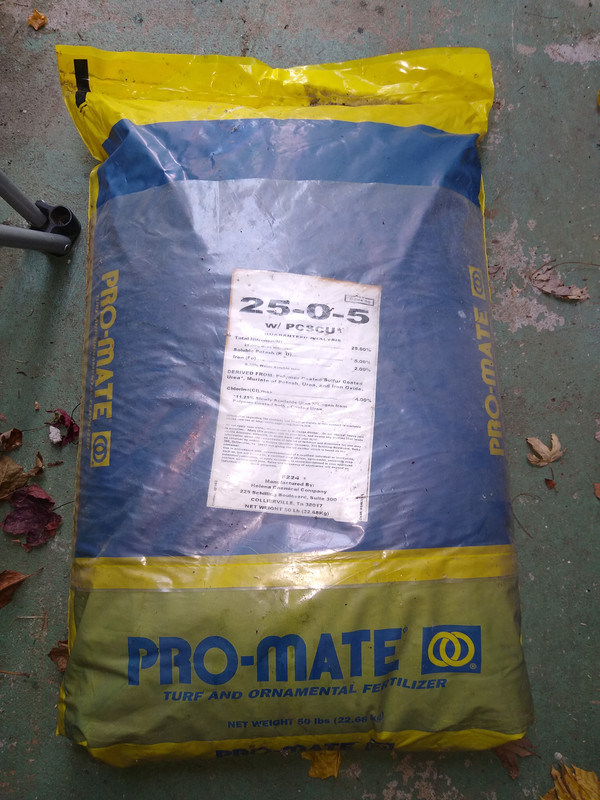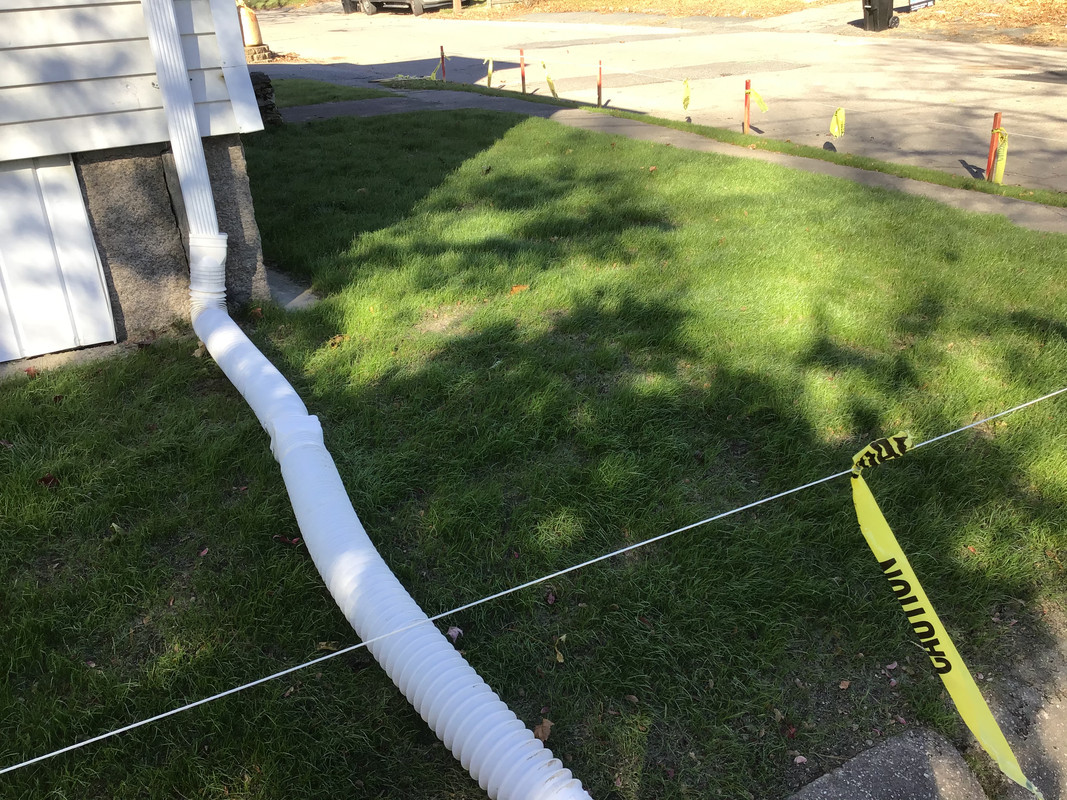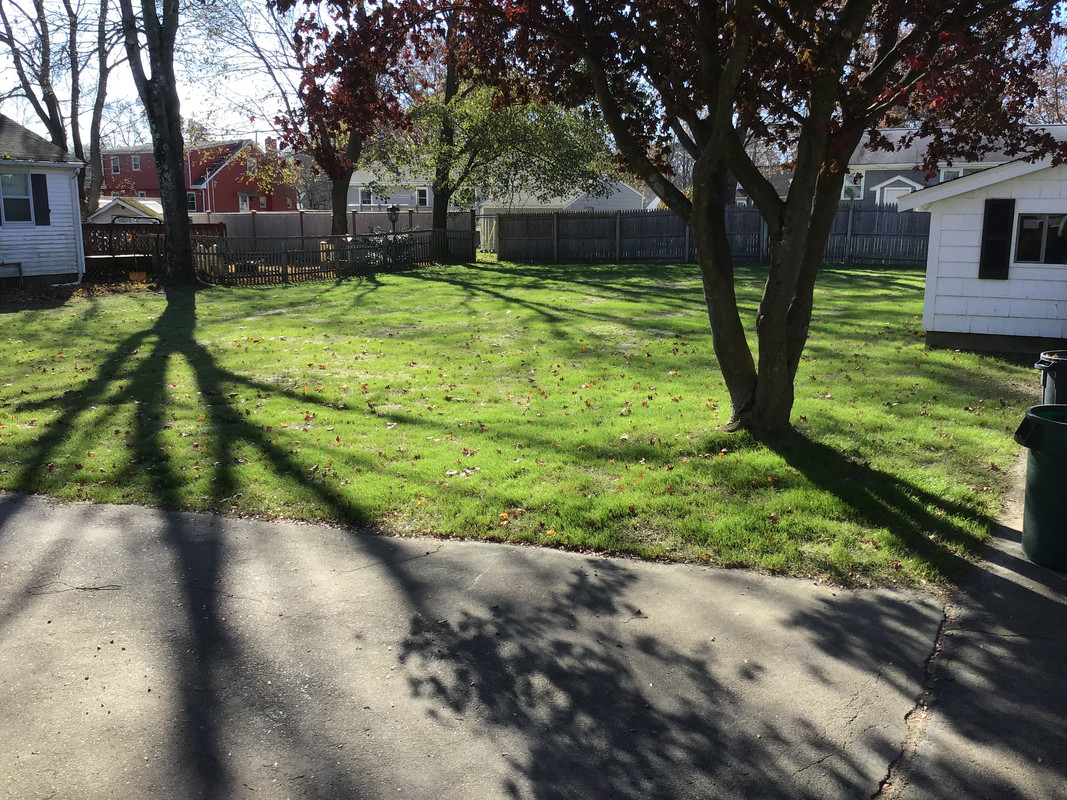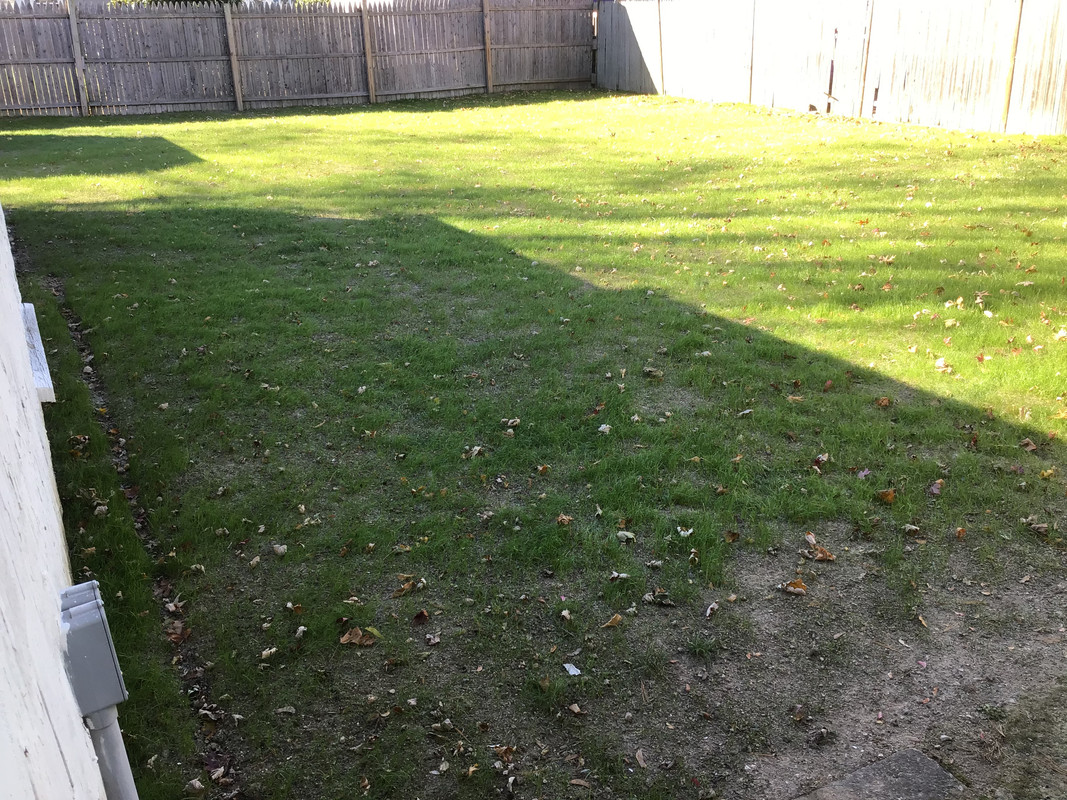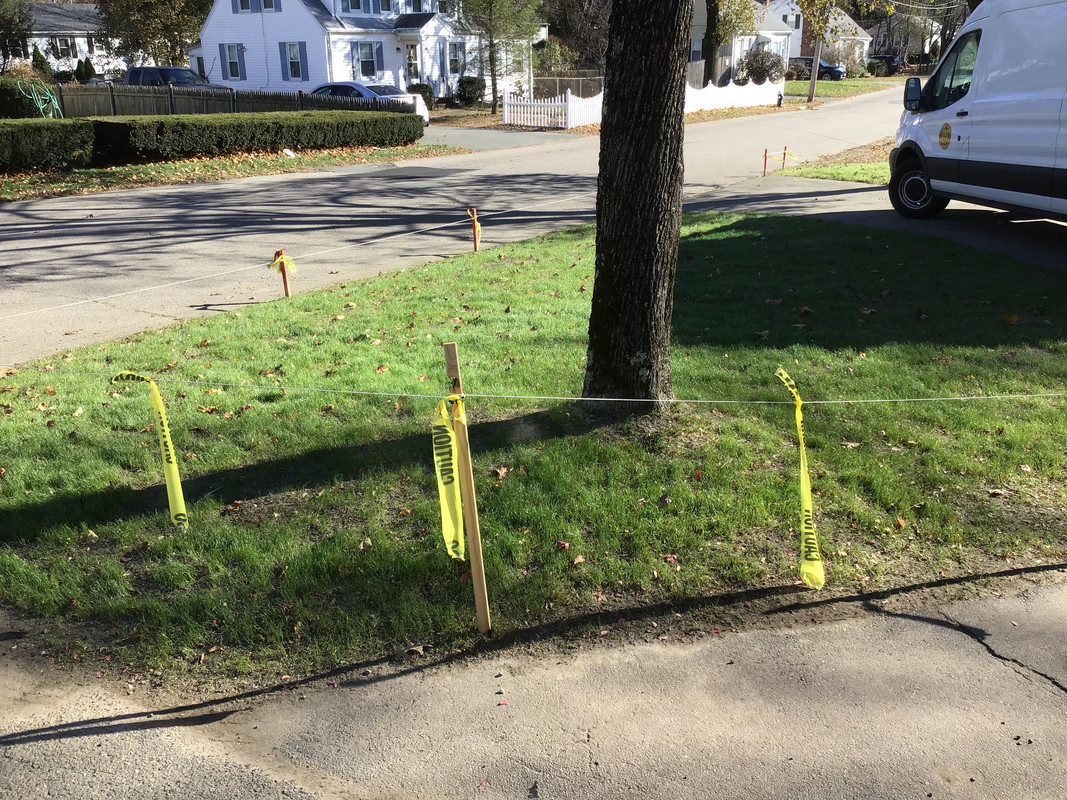Hello guys. New to the forum. Just had my lawn rehabed. I know it was a lil late but had to do it. Old lawn ripped up new loam put down and hydroseed with a rye/ fescue mix. Grass has been up for a couple weeks now. Was wondering if I should put a winter fertilizer down and if so when? It's gonna be cold here the next week or so and thinking the growing is going to be halted pretty much. Just want to make sure it survives in it delicate state right now. Any help is appreciated

Dhark
Winter fertilizer after new seeding?
2 reading
Dhark
Discussion starter
42 posts
·
Joined 2019
- Add to quote Only show this user
Hello guys. New to the forum. Just had my lawn rehabed. I know it was a lil late but had to do it. Old lawn ripped up new loam put down and hydroseed with a rye/ fescue mix. Grass has been up for a couple weeks now. Was wondering if I should put a winter fertilizer down and if so when? It's gonna be cold here the next week or so and thinking the growing is going to be halted pretty much. Just want to make sure it survives in it delicate state right now. Any help is appreciated
10,693 posts
·
Joined 2017
Last year, I seeded an area. I put down starter fertilizer with the seed. Then, nothing else until my final application. In the Spring, it exploded and filled in well. I added more partway into the Spring.
If you decide to do this, don't put down any fertilizer until you've done the last mow, or alternatively, once you've started mowing again next Spring. Doing it right now isn't the best idea, because the growth is trying to slow down. Better to do it this year once you're done mowing, or wait until next Spring after you've mowed a couple of times. Also, try to avoid high Potassium fertilizer if you do it late in the Fall.
If you decide to do this, don't put down any fertilizer until you've done the last mow, or alternatively, once you've started mowing again next Spring. Doing it right now isn't the best idea, because the growth is trying to slow down. Better to do it this year once you're done mowing, or wait until next Spring after you've mowed a couple of times. Also, try to avoid high Potassium fertilizer if you do it late in the Fall.
3,254 posts
·
Joined 2017
For New England it is late but you could put down a application of nitrogen when top growth stops which I think will be soon if not already. The addition of winterizer is a debatable topic and I for one am not adding a winterizer this year. With that being said being you have not added any fertilizer I might be incline to go ahead and drop .50 lb - 1 lb of nitrogen to hopefully help the new grass roots develop better. It's no guarantee it will help but won't hurt.
Dhark
Discussion starter
42 posts
·
Joined 2019
Thanks guys. I don't think it's grown enough to mowed. I did put some starter fert down with the seed. My landscaper said I could put lime down as in his words is winter fertilizer. Just want to make sure it survives the winter and get some good root growth
3,254 posts
·
Joined 2017
Definitely don't add lime without a soil test. If you already have high ph level it would be a terrible idea to raise it more.Dhark said:Thanks guys. I don't think it's grown enough to mowed. I did put some starter fert down with the seed. My landscaper said I could put lime down as in his words is winter fertilizer. Just want to make sure it survives the winter and get some good root growth
17,369 posts
·
Joined 2017
^ +1
Frequent mowing will encourage spreading. But with the early winter temps, I doubt you will see a lot of spreading this year.
Frequent mowing will encourage spreading. But with the early winter temps, I doubt you will see a lot of spreading this year.
3,254 posts
·
Joined 2017
Generally you'd want to use urea or ammonium sulfate. You won't be able to find those at your local garden centre though so if your not able to locate them try and find something with the highest percentage of fast release nitrogen and no potassium.Dhark said:Any suggestions on what particular product to use?
Dhark
Discussion starter
42 posts
·
Joined 2019
Hmm I woulda thought slow release to give a steady supply over the winter? This is all new to me sorry. So something like Scott's or Stagreen fall/winter fertilizer would be ok? Or something more specific like the products you mentioned are better?
10,693 posts
·
Joined 2017
That 50/50 blend would be awesome back in mid to late September. You can use it this Fall if it's what you have, but it'd work better in either September or even June, to get the most bang for the buck from it.
10,693 posts
·
Joined 2017
Doesn't really work that way...first, the ground is mostly frozen from early Jan to late Feb. Second, the plants are dormant and can't really use it anyway, even if the ground thaws.Dhark said:Hmm I woulda thought slow release to give a steady supply over the winter? This is all new to me sorry. So something like Scott's or Stagreen fall/winter fertilizer would be ok? Or something more specific like the products you mentioned are better?
Scotts is a great choice for late Fall, but just get the regular Turfbuilder or GreenMax, instead of the Winterguard. I will be using GreenMax, personally, in a couple of weeks.
2,701 posts
·
Joined 2019
Here's what I've gathered on Winterizers from this group and others, esp for your area. I'm not a pro by any means but have been learning a lot asking these same questions as I'm learning about growing TTTF in the deep south.
There are generally 2 fall applications: an early fall one (around over-seeding time, which is meant to encourage recovery & growth) and a late-fall application (typically falls around mid-late Nov for your area, after the grass stops growing but before the ground freezes). Whereas the first application needs to last you +/- 8 weeks (or you can follow the fall nitrogen blitz idea and apply quicker-release fert at shorter intervals over this same time period), the last fall application has a shorter window before ground freezes and nutrient uptake is no longer possible (and whatever Nitrogen is left lingering on the surface will leach out, unused by the plants). If you can get the plant to absorb the N it will hold onto it through the winter. In the meantime it makes the plant hearty overwinter and allows it to come out of dormancy with vigor come warmer temps.
The bag of fert you posted, as Green mentioned, is ideal for a longer-duration release timeframe (perfect for that first fall app) because it has been manufactured with a lot of extra steps and materials in order to encapsulate the volatile urea so as to have a controlled release (6-8 weeks, +/-). It's generally much more expensive for this reason ($20-25 vs $40-50++). Because the ground will freeze before the full release of the nutrients you're not only wasting the nutrients that were captured & manufactured into that fert but also supplying these chemicals into the ground at a time when they'll simply leach into the groundwater, etc. For this reason the suggested product is a quick-release Urea or Ammonium Sulfate fert for this late fall application. *note: because these recommended products are not sold at big-box stores and some ppl don't have direct access to them, the big-box fert with 15-20% slow release is a compromise.
Here's a basic explanation on the PCSCU process btw, in case you appreciate the details as I do:

There are generally 2 fall applications: an early fall one (around over-seeding time, which is meant to encourage recovery & growth) and a late-fall application (typically falls around mid-late Nov for your area, after the grass stops growing but before the ground freezes). Whereas the first application needs to last you +/- 8 weeks (or you can follow the fall nitrogen blitz idea and apply quicker-release fert at shorter intervals over this same time period), the last fall application has a shorter window before ground freezes and nutrient uptake is no longer possible (and whatever Nitrogen is left lingering on the surface will leach out, unused by the plants). If you can get the plant to absorb the N it will hold onto it through the winter. In the meantime it makes the plant hearty overwinter and allows it to come out of dormancy with vigor come warmer temps.
The bag of fert you posted, as Green mentioned, is ideal for a longer-duration release timeframe (perfect for that first fall app) because it has been manufactured with a lot of extra steps and materials in order to encapsulate the volatile urea so as to have a controlled release (6-8 weeks, +/-). It's generally much more expensive for this reason ($20-25 vs $40-50++). Because the ground will freeze before the full release of the nutrients you're not only wasting the nutrients that were captured & manufactured into that fert but also supplying these chemicals into the ground at a time when they'll simply leach into the groundwater, etc. For this reason the suggested product is a quick-release Urea or Ammonium Sulfate fert for this late fall application. *note: because these recommended products are not sold at big-box stores and some ppl don't have direct access to them, the big-box fert with 15-20% slow release is a compromise.
Here's a basic explanation on the PCSCU process btw, in case you appreciate the details as I do:

2,701 posts
·
Joined 2019
@Dhark - the information SiteOne gave you is not completely untrue as Urea, in the un-encapsulated 46-0-0 formulation, is a fast-release nitrogen source... which is analogous to higher-potency and hence higher risk . The issue then is if you feel comfortable applying a more concentrated fertilizer on your lawn, with all its risks & rewards. If you're not there yet then choose the Scotts Turfbuilder as @Green suggested. It is definitely a safer choice.
10,693 posts
·
Joined 2017
46-0-0 is also a pain to spread evenly. Doing a 0.5 or lower app with a broadcast spreader on a small area (like 1,000 square feet) can by annoying because the prills are large and tend to bounce around the spreader and so coverage might not be even on small areas. Remember, you ideally want to split each app in half and go in two sets of passes in perpendicular directions.
Dhark
Discussion starter
42 posts
·
Joined 2019
G-man now I'm really confused. I just read your fall nitrogen blitz regimen. And you say that ; "Lastly, this is not intended for a recently (3-4 weeks ago) seeded lawn since the grass is too young to be forced to grow with nitrogen. Let it grow a winter before doing this. During an overseed/reno use a spoon feeding approach."
Seeing my grass is only been up for about 3 weeks wouldn't I fall into this category? Do you think the stuff they sold me is useless at this time? Just want to do the right thing here
Seeing my grass is only been up for about 3 weeks wouldn't I fall into this category? Do you think the stuff they sold me is useless at this time? Just want to do the right thing here
10,693 posts
·
Joined 2017
@Dhark, low doses are fine before the pause period on new grass. But 21% Potassium might actually be a bit risky. Her advice is outdated.
I don't think there's anywhere in New England that is not in the pause (or even stopped growing) yet.
I would definitely use something like Scotts 27-0-2 or 32-0-4 over the stuff she sold you. The 21-0-21 is good for Spring, again in small amounts (unless your soil test says not to apply K).
I don't think there's anywhere in New England that is not in the pause (or even stopped growing) yet.
I would definitely use something like Scotts 27-0-2 or 32-0-4 over the stuff she sold you. The 21-0-21 is good for Spring, again in small amounts (unless your soil test says not to apply K).
Dhark
Discussion starter
42 posts
·
Joined 2019
Seems there's a lot of conflicting ideas out there and being a newb isn't easy. I really appreciate everyone's input. I am trying to absorb all of this and it's obviously a pretty complicated puzzle. Can someone chime in on this websites advice of not giving high doses of N to new lawns (my situation) and using larger amounts of P and K instead?
http://www.garden-counselor-lawn-care.com/fertilizer-numbers.html
http://www.garden-counselor-lawn-care.com/fertilizer-numbers.html
10,693 posts
·
Joined 2017
@Dhark, Potassium in Fall is potentially risky where snow mold occurs, the risk increasing with the larger the amount applied. So we often try to minimize how much we use in Fall.
Too much Nitrogen in Spring can carry risk of increasing other diseases.
Of course, Fall is the best time for Nitrogen. But it's best to stop at the "Pause", because continuing too long can increase snow mold risk or even cause or worsen cold damage and potentially result in more dead spots over Winter.
New grass is a little different. It's smaller and doesn't have as much root mass. In both Fall and Spring, small amounts of N, applied frequently, are best. The pause and the Potassium issues still apply in Fall with new grass. In the Spring, you can use Potassium without snow mold risk, so if your soil test says you need K, it's best to spoonfeed with it along with the N. And since the new grass also needs P, you should include it as well, unless your soil test says you don't need it. But small amounts of all three at any given time, every other week are best. Spoonfeeding can mean below 0.25 lb/M. Once the grass matures a bit (after 60 or so growth days) you can use 0.25 or even 0.5 lb N at time every few weeks, and it will utilize it. If you want to get even more precise and be really careful, don't put any fertilizer, even spoonfeeding amounts, on new grass until you have mowed it 1 or 2 times (past the "pout" stage where it hardly grows). And pick NPK fertilzer containing Potassium Sulfate (SOP) instead of Potassium Chloride (MOP).
Too much Nitrogen in Spring can carry risk of increasing other diseases.
Of course, Fall is the best time for Nitrogen. But it's best to stop at the "Pause", because continuing too long can increase snow mold risk or even cause or worsen cold damage and potentially result in more dead spots over Winter.
New grass is a little different. It's smaller and doesn't have as much root mass. In both Fall and Spring, small amounts of N, applied frequently, are best. The pause and the Potassium issues still apply in Fall with new grass. In the Spring, you can use Potassium without snow mold risk, so if your soil test says you need K, it's best to spoonfeed with it along with the N. And since the new grass also needs P, you should include it as well, unless your soil test says you don't need it. But small amounts of all three at any given time, every other week are best. Spoonfeeding can mean below 0.25 lb/M. Once the grass matures a bit (after 60 or so growth days) you can use 0.25 or even 0.5 lb N at time every few weeks, and it will utilize it. If you want to get even more precise and be really careful, don't put any fertilizer, even spoonfeeding amounts, on new grass until you have mowed it 1 or 2 times (past the "pout" stage where it hardly grows). And pick NPK fertilzer containing Potassium Sulfate (SOP) instead of Potassium Chloride (MOP).
17,369 posts
·
Joined 2017
@Dhark
You have a very young lawn at 3 weeks. It barely has a root mass/structure to grab on to nutrients. On top of the young lawn, we had an early winter this year. In Indy it is very cold and the lawn has slow down or gone dormant. I think that in your case, adding nitrogen now is a waste of money. Most (or all of it) of it will not be absorb by the roots. Feed the lawn in spring at small frequent doses. Get a soil test to see if there are nutrient deficiencies (Phosphorous, Potassium) and to adjust pH.
You have a very young lawn at 3 weeks. It barely has a root mass/structure to grab on to nutrients. On top of the young lawn, we had an early winter this year. In Indy it is very cold and the lawn has slow down or gone dormant. I think that in your case, adding nitrogen now is a waste of money. Most (or all of it) of it will not be absorb by the roots. Feed the lawn in spring at small frequent doses. Get a soil test to see if there are nutrient deficiencies (Phosphorous, Potassium) and to adjust pH.
Dhark
Discussion starter
42 posts
·
Joined 2019
I think I'm just gonna get a small bag (5000 sq ft) of either turf builder Or greenmax as @green mentioned. Put it down today or tomorrow before some rain Monday to wash it in, then It's gonna be 45-50 degrees all week with lows at night right about the freezing mark. The grass is 3-4" is some spots and only a couple Inches in others. Would you recommend cutting it or just leaving it? I did a little light raking to get some of the Japanese maple saplings out of the lawn and noticed it pulled some grass out even though I was going pretty gentle. I'm worried the lawn mower will pull it right up as well. And if you do recommend a mowing should I bag or mulch
10,693 posts
·
Joined 2017
If you don't think you can mow without damaging it, leave it. If you can mow without pulling it up, try to mow it down to 2-2.5 inches or so if you can without scalping. I'm going to be doing 2.6 inches for my last mow, but it will cut lower in some areas, and I will try not to scalp. Maybe you can mow some areas.Dhark said:The grass is 3-4" is some spots and only a couple Inches in others. Would you recommend cutting it or just leaving it? I did a little light raking to get some of the Japanese maple saplings out of the lawn and noticed it pulled some grass out even though I was going pretty gentle. I'm worried the lawn mower will pull it right up as well. And if you do recommend a mowing should I bag or mulch
If you drop the fertilizer, make sure it's not growing. Not knowing if you're in CT or Maine for example, can make a big difference in when it stops.
-
?
-
?
-
?
-
?
-
?
-
?
-
?
-
?
-
?
-
?
-
?
-
?
-
?
-
?
-
?
-
?
-
?
-
?
-
?
-
?
- posts
- 664K
- members
- 43K
- Since
- 2017
A forum community dedicated to lawn care, landscaping do it yourselfers, and enthusiasts. Come join the discussion to learn about industry equipment, tools, lawn care, lawn maintenance, classifieds, troubleshooting, and more!

